In today’s digital world, businesses rely heavily on online services and applications. Whether hosted or open-source, a status page isn’t just a nice-to-have—it’s an essential part of your incident communication strategy. It helps IT and support teams keep users informed, build trust, and reduce the flood of support tickets during outages.
Instead of manually sending emails or posting updates across multiple channels, a status page provides a centralized and automated way to communicate service status. But when setting up a status page, you have two main options:
- A SaaS solution (fully managed, no maintenance required).
- A self-hosted, open-source solution (more control, but requires management).
If you’re weighing self-hosted vs. hosted status pages, check out our in-depth comparison: Hosted vs. Self-Hosted for Your Status Page—Which Is Best?.
But if you’re set on self-hosting, this post is for you! Below, we’ve ranked some of the best open-source status page alternatives, so you can find the right fit for your needs.
- Open-Source Status Pages Comparison Table
- 1. Uptime Kuma
- 2. Cachet
- 3. Vigil
- 4. Kener
- 5. Upptime
- 6. CState
- 7. Gatus
- 8. Notion-Based Status Page Template
- Conclusion
We’ve compiled the 8 best free and open-source status page solutions available today. Instead of ranking them, we’ve outlined key comparison points so you can choose the one that best fits your needs.
Check out the comparison table below, and scroll down for a deeper dive into each option.
| Status page | Notification channels | Monitoring | Multi-language | Stack | OSS Model | |
|---|---|---|---|---|---|---|
| Uptime Kumar | ✅ | 90+ | HTTP, TCP, DNS, and more! | ✅ | JS, Vue | Open Source |
| Cachet | ✅ | ❌ | ❌ | PHP | Open Source | |
| Kener | ✅ | ❌ | HTTP Pull/Push, APN | ✅ | JS, Svelte | Open Source |
| CState | ✅ | RSS, Email | ❌ | ✅ | HTML, Github | Open Source |
| Vigil | ✅ | 11+ | HTTP, TCP, ICMP, local agent | ❌ | Rust | Open Source |
| Upptime | ✅ | 9 | HTTP | ❌ | GitHub Actions, Issues, Pages | Open Source |
| Notion Template | ✅ | ❌ | ❌ | ❌ | Notion | Open Core |
| Gatus | ✅ | 20+ | HTTP, TCP, DNS, and more! | ❌ | Go | Open Core |
1. Uptime Kuma
Uptime Kuma is a self-hosted monitoring tool with status pages support. It's known for its ease of use and comprehensive features. It offers a range of monitoring capabilities for various protocols and services.
Key features of Uptime Kuma
- Monitoring for multiple protocols like HTTP(s), TCP, DNS, and more.
- A fast and reactive user interface.
- Notifications through numerous services, including Telegram, Discord, and Email.
- Frequent monitoring intervals (as low as 20 seconds).
- Support for multiple languages and status pages.
Additional functionalities like certificate info, proxy support, and two-factor authentication.
2. Cachet
This brings us to the old hand and top dog among the free status sites: Cachet.
The first thing that stands out is that Cachet is big. The open source project has many contributors, extensive documentation and even its own Slack community, which is always happy to help with questions.
You will however need to configure and maintain a server with Cachet and is slightly less straightforward than some previously mentioned alternatives.
Other than that, the user interface is a delight and the dashboard is clearly laid out. You can create incidents, monitoring services, scheduled maintenances as well as your own metrics. Furthermore you can add subscribers and team members with different rights. Cachet provides two-factor authentication for this purpose.
The customizable status page is also particularly convenient for your users. The powerful JSON API pleasantly completes the picture.
UPDATE: Version 3.x of Cachet is coming soon
Cachet creator, James Brooks, who has experienced personal challenges and growth, including a loss in the family and a new job at Laravel, is now rebuilding Cachet using modern technologies like Vue.js, Inertia, Laravel 10.x, and Tailwind.
The plan includes supporting only PHP 8.1 and above, possibly dropping non-English translations temporarily, and ensuring existing installations remain functional. The rebuild will be extensive, requiring closing of current issues and pull requests in the repository.
James seeks community collaboration, including assistance in front-end development, testing, documentation, and financial sponsorship.
Key features of Cachet
- Incident, maintenance, monitoring metrics
- Subscribers & team members
- Nice and easy to use dashboard
- Two factor authentication
- Customizable status page
- Powerful JSON API
- Extensive documentation
3. Vigil
A somewhat simpler service is Vigil. The program can do everything that a status page should be able to do - incident creation, monitoring and notification via plenty of channels (e.g. Email, SMS, Slack, Telegram).
Vigil is another service that requires self-hosting. An interesting fact is that Vigil is writing in Rust, so you’ll need either cargo or OPTopt to use the dockerized version.
A great advantage of Vigil is that it can be used internally on a company lan network. For a small company certainly a good and free service for internal use.
Key features of Vigil
- Generates status page
- Notifications (Email, SMS, Slack, Telegram, and many more)
- Vigil local can be internally used (e.g. LAN)
4. Kener
If you’re looking for a modern, nicely designed, and Github-based status page that automatically monitors the status of your services, then Kener is just for you.
Kener uses your Github account as the storage for your incident reporting. Integrating easily with how your team already works and collaborates.
Kener is completely open-source, built with Node.js, Svelte, and Tailwind, making it extremely easy to extend and customize.
Key features of Kener
- Real-time Monitoring: Enables real-time monitoring of services using either polling of HTTP endpoints or push data via REST APIs.
- Flexible Configuration with YAML: Allows for flexible monitor configuration using YAML, including custom definitions for service statuses like UP, DOWN, or DEGRADED.
- Cron-based Scheduling: Supports cron-based scheduling for monitors with a minimum frequency of per minute, along with a default status option.
- Customizable Status Pages: Provides options for customizing status pages using YAML or code, and includes badge generation for monitor status and uptime.
- Branding and Embedding Features: Offers support for custom domains and the ability to embed monitors as iframes or widgets, complemented by light and dark themes.
- Incident Management: Allows creation of incidents using Github Issues or APIs, with support for rich text in incidents.
- User Experience and Design: Focuses on a user-friendly interface with 100% accessibility score, easy installation, responsive design for various devices, and auto SEO and social media readiness.
5. Upptime
Upptime is one of our absolute favorites. The service is completely open source and very user-friendly. You don't need your own server since the status page is hosted directly via Github Services.
For a free status page, Upptime can do a lot: Incident creation, monitoring service, display of active and past incidents, live status and scheduled maintenances.
If one of your systems should crash, you can set up notifications via different external providers.
Best of all, Upptime creates an automatic Github issue for incidents and also closes it again as soon as the incident is resolved. This way, the developer team can always keep an eye on your services.
Key features of Upptime
- Opens and closes a github issue automatically(good for dev team)
- Commits for response time
- No server required, powered entirely by github
- Active incidents, scheduled maintenance, live status, past incidents
- Notifications to different services
- Handy UI
6. CState
CState is another minimalist option, interestingly based on Hugo (static site generator). Thanks to that, it can be easily hosted via various providers such as Github or Netlify and runs extremely fast due to the static structure of the site.
CState provides all the most important features a status page should have, namely incident and maintenance reporting and history.
Individual customizations are also feasible. In addition, a built-in package with translations into eight different languages, including Spanish, Portuguese, Turkish and Dutch, is included. In case of complications, a limited support helps you for a small fee- or even with the installation.
Key features of CState
- Serverless Architecture: Utilizes a static, serverless design for efficiency and speed.
- Hyperfast Performance: Built with Go & Hugo for exceptional performance.
- Customizability: Highly customizable with minimalistic HTML/CSS/JS.
- Preloaded CMS and Read-Only API: Includes a preloaded content management system and a read-only API for ease of use.
- Badge Generation: Offers badge creation for various statuses.
Excellent Browser Support: Compatible with a wide range of browsers, including older versions like IE8.
7. Gatus
Gatus is an automated service monitoring and status page solution designed for simplicity and ease of use. It allows you to define health checks for your services and automatically updates the status page based on their responses.
Key Features:
- ✅ Automated Monitoring – Define health checks via YAML configuration.
- ✅ Self-Hosted – Deployable with Docker or as a standalone binary.
- ✅ Customizable Alerts – Supports Slack, Discord, email, and more.
- ✅ Lightweight & Fast – Built with performance in mind.
Pros & Cons:
⬆️ Pros:
- Easy to set up with minimal configuration.
- Automatic status updates based on service health.
- Supports multiple alerting integrations.
🔻 Cons:
- Primarily a monitoring tool, not a full-fledged status page solution.
- Requires manual setup and hosting.
If you're looking for a lightweight, self-hosted status page with built-in monitoring, Gatus is a great option.
8. Notion-Based Status Page Template
For those who are already relying heavily on Notion and want a free and easy-to-use status page without dealing with server hosting, the Notion-based status page template is a great alternative. While it’s not an open-source solution in the traditional sense, it allows full customization and can be used as a self-hosted status page within Notion.
Key Features:
- ✅ Fully Editable & Customizable – Modify the template to match your needs.
- ✅ Free & No Hosting Required – No server setup needed, just a Notion account.
- ✅ Collaboration-Friendly – Multiple team members can update the page easily.
- ✅ Supports Embedded Content – Add external links, incident reports, and more.
Pros & Cons:
⬆️ Pros:
- Zero hosting or maintenance required.
- Fully customizable to fit your brand.
- Simple and accessible, even for non-technical users.
🔻 Cons:
- Not open-source; dependent on Notion’s platform.
- Limited automation compared to dedicated status page solutions.
If you're looking for a lightweight, no-code solution, a Notion-based status page can be a quick and effective way to keep users informed.
Conclusion
If you’d prefer not to have to configure and maintain a new server, and don’t mind relaying in a service like Github or Netlify, Upptime and CState are a great choice.
However if a simple monitoring service and slick status dashboard is what you’re after, Monitoror with its geeky design is probably the best option for you.
Now, if you don’t mind the extra effort of setting up and maintaining your own server, and want a more powerful alternative to the above, then you can’t go wrong with Cachet, Statping or Vigil. Especially Cachet stands out with its long history, many contributors and its excellent and comprehensive documentation.
Finally, if you find yourself outgrowing these free and open source alternatives, it might be time for you to consider a modern SaaS solution, like StatusPal, where you’ll get all of the features described above and then some, bundled with amazing and responsive support that can help you get up and running in a few minutes.
Examples of Open-Source Status Pages
As a bonus, here are a couple of great examples of status pages built with the above open source tools:
Twin Status Page - Powered by Gatus
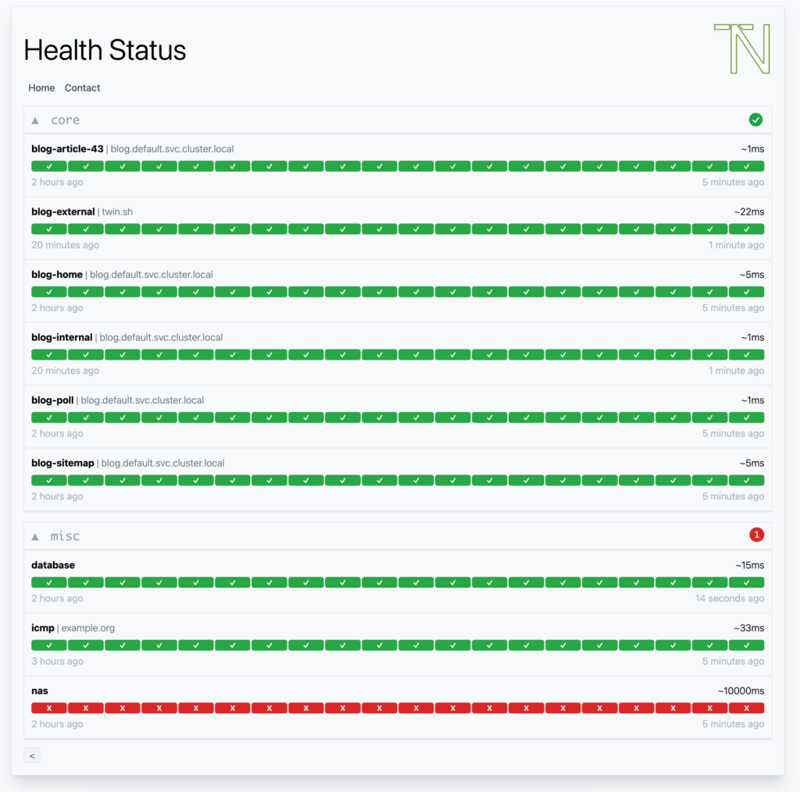 Crip Status Page - powered by Vigil
Crip Status Page - powered by Vigil
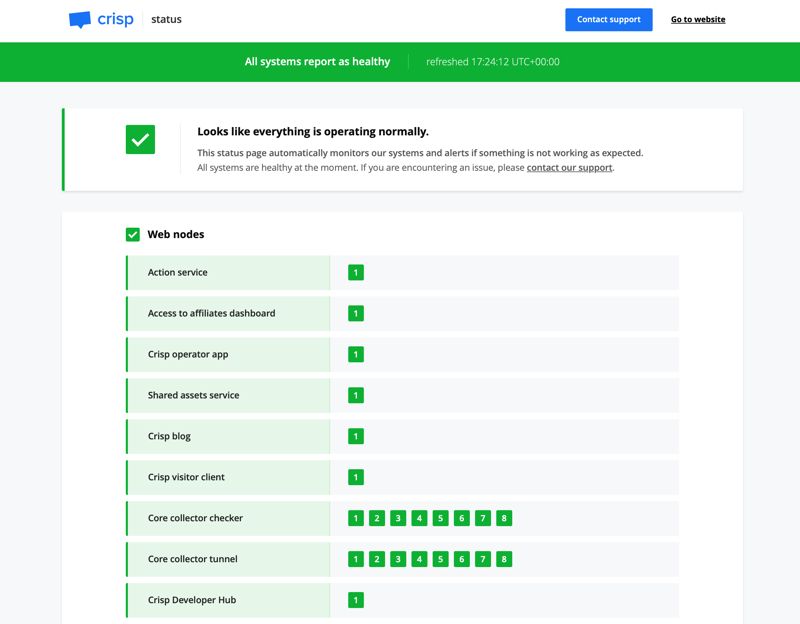 Meilisearch Status Page - powered by Vigil
Meilisearch Status Page - powered by Vigil
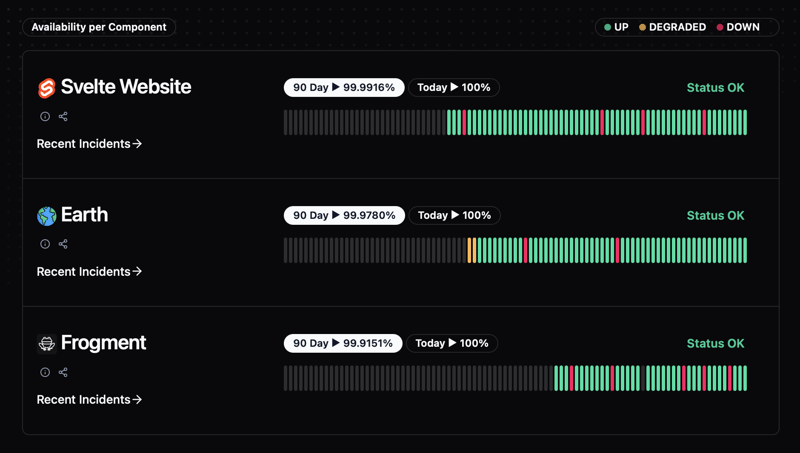 FSCI Status Page - powered by CState
FSCI Status Page - powered by CState


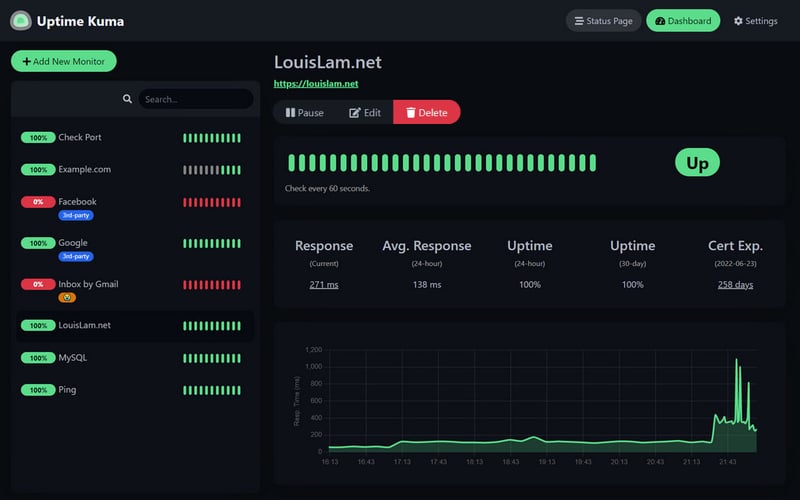
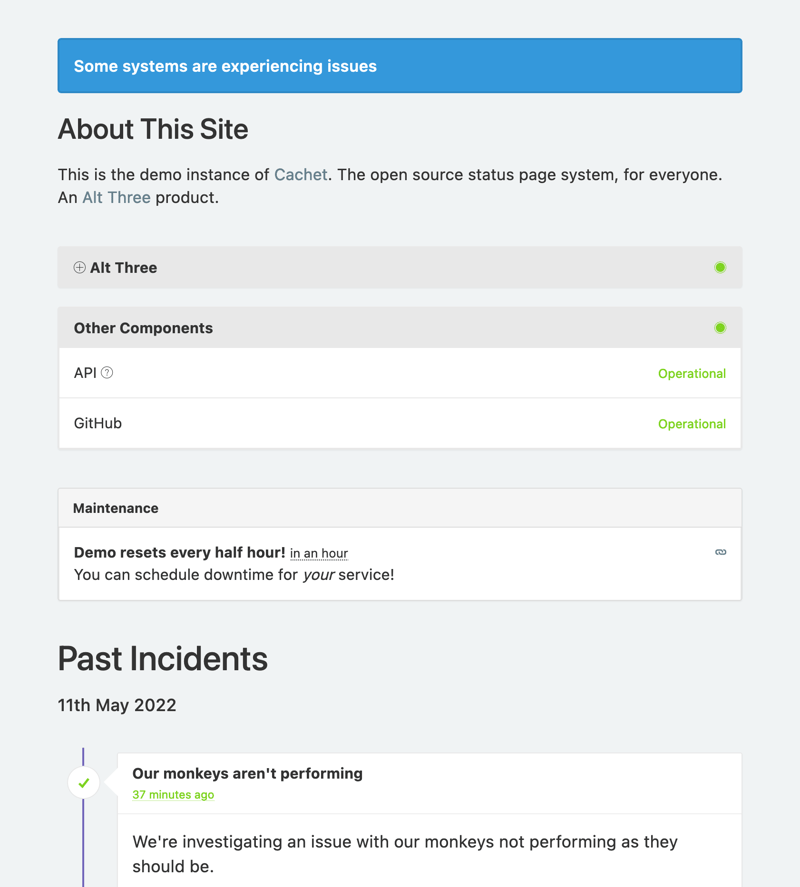
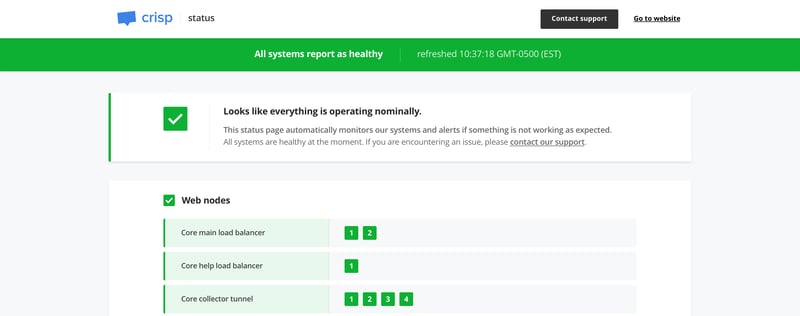
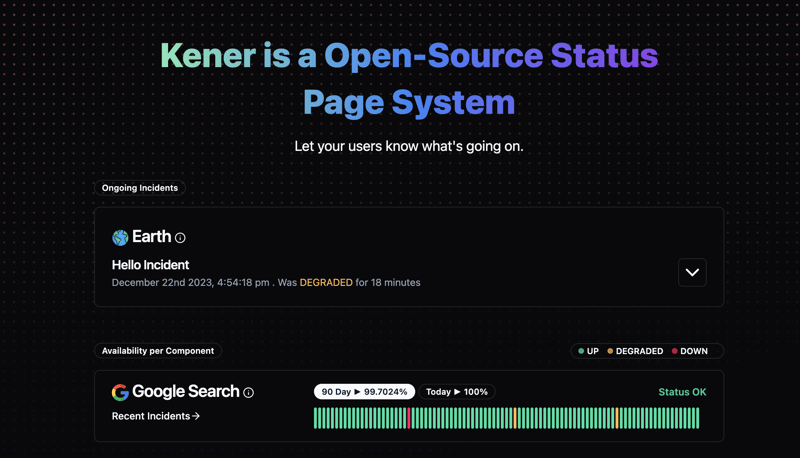



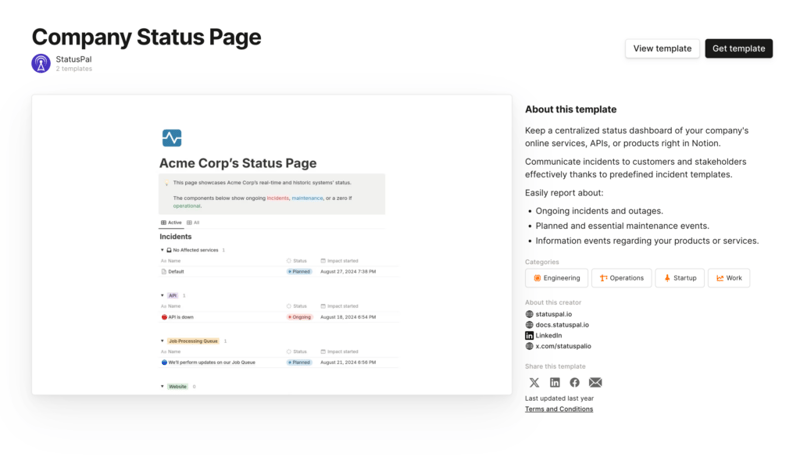
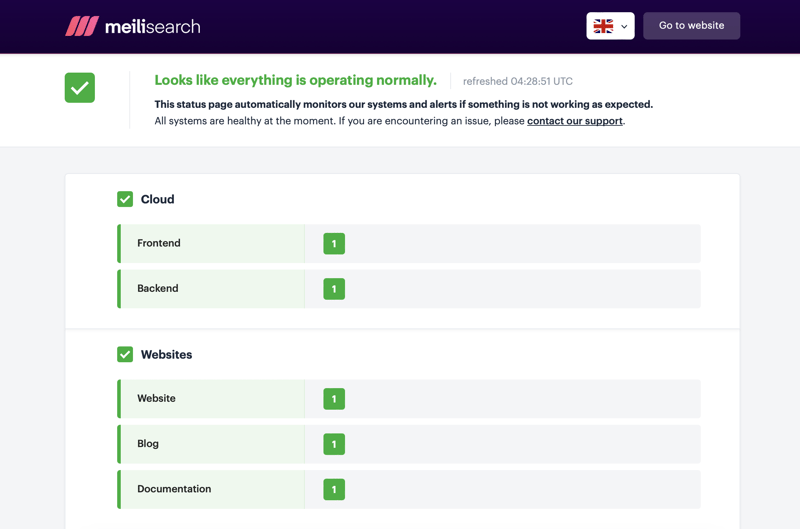
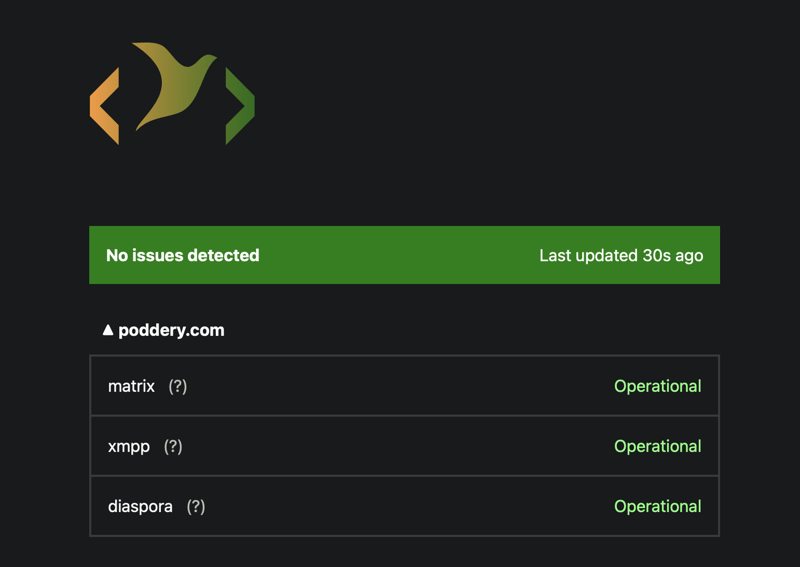
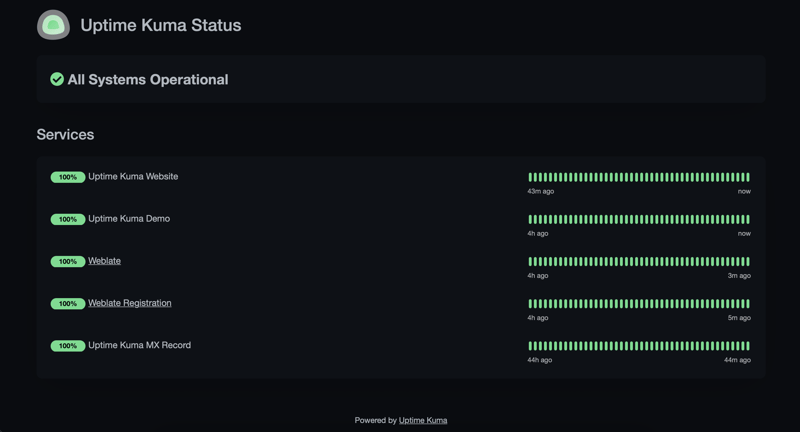

Top comments (2)
OpenStatus is another open-source status page alternative, simple and elegant.
key features
link to GitHub ↗︎
Thanks @fmerian! We'll keep it in mind for the next revision of our list :)